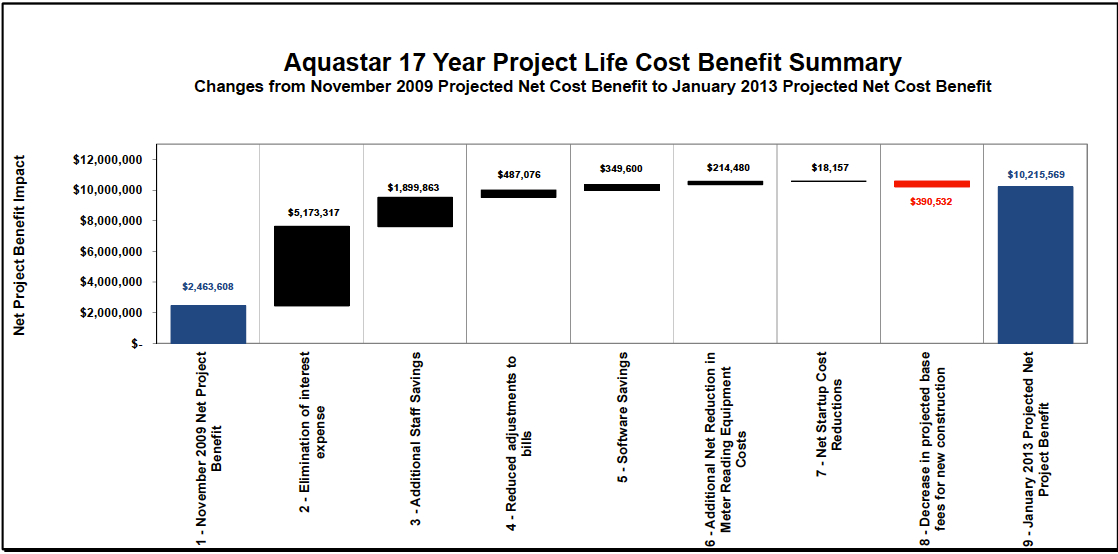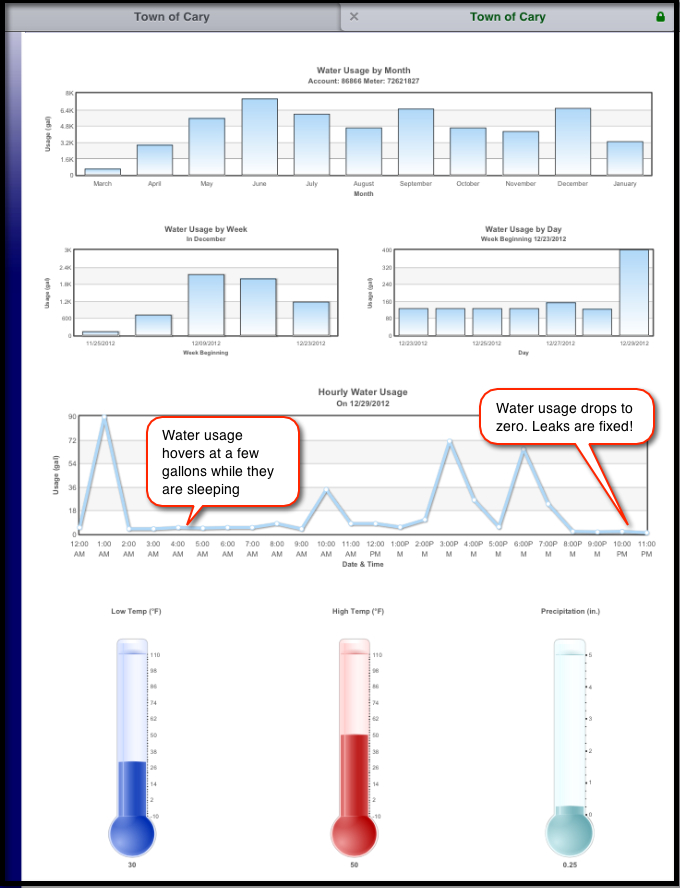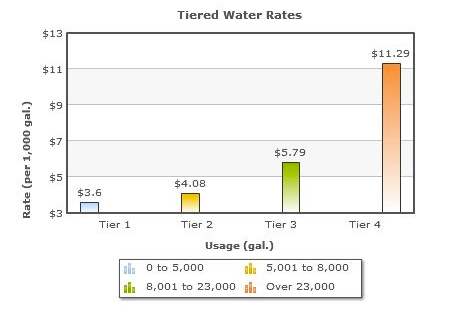Lori Bush: Deep Dive Into Aquastar
Story by Lori Bush. Republished from her blog. Lead photo by Steven Depolo. Other pictures from Town of Cary.
Cary, NC – One of the truly innovative and cost-saving projects that I’ve been privileged to learn about since I joined Town Council is Aquastar.
Aquastar – Automated Water Metering
Aquastar is the name we use in Cary to refer to the advanced metering infrastructure (AMI) system for our water.
The Aquastar program replaces what WAS the monthly manual reads of your water meter, with a wireless system that collects multiple remote meter reads every day.
The technology used is often referred to as part of a Smart Grid infrastructure. The vendor of the system, Sensus (in Raleigh), worked closely with the town to find the right solution, while Johnson Controls developed and managed the project. (In what the Town Staff refers to as “The Cary Way.” I like that!)
You can even watch a video from the Town that explains how Aquastar works.
Aquastar History
The project started with a proposal in November of 2009, when Cary was manually reading over57,000 meters per month in Cary and Morrisville. (Yes, Cary is the water utility provider to Morrisville.) That meant that trucks were rolling – and a number field personnel working for the Town were driving to your neighborhood and walking to read your water meter.
With this new system of 63,000 wireless water meters, the system can monitor water usage and report the usage back to Town Hall. That means that the Town will realize the cost savings associated with:
– significantly reduced fuel consumption (over 7,000 gallons a year),
– a lower carbon footprint (71,000 miles of truck usage off the road),
– along with reduced headcount (10 people), and reduced worker’s compensation by reducing job-related injuries.
The total budget of the project is $17.9 million, which was funded through the Town’s utility fund. Originally, Aquastar was projected to save the Town (and taxpayers) $2.4 million dollars. (Which is great!)
However, the finance department has found that THAT number was conservative. A recent cost analysis shows that we will save close to $10.2 million dollars, which is great news for our utility ratepayers!

Saving Water
There are also other huge benefits besides the cost savings. With this system, we can find a leak when it’s much smaller – so that it can be repaired more proactively, and sometimes, finding leaks earlier means a cheaper repair. And, of course, conservation is another key benefit.
By giving our citizens actionable information about their water usage, the hope is that it gives us EACH the power to see what we are using, and potentially make changes to reduce our water usage.
Here’s how it works
- All of our commercial and residential water meters have been replaced with Aquastar meters – meters with a wireless capability
- Each meter will send water usage information to a regional collector 4 times a day.
- The collector will forward that information to Town Hall.
- And, starting in March, customers will have access to a Website with detailed information that will provide a graphical view of their water usage. (This will be available from your Online Billing page.)
With this capability, the Utility services will have more than 500 million data points per year. This will help narrow down any problems in the system, and also for them to notice any trends that may help improve efficiencies.
The members of the Information Services Advisory Board and members of the Technology Task Force got a sneak peak into the tool recently. They all gave valuable feedback, and a number of changes have been made based on that feedback. New enhancements to the tool are also coming, so make sure to give you comments, as well.
What can you learn from all this data?
Well, quite a lot. The Aquastar web portal will show you a rolling 13 months of data – giving you the ability to compare your most recent month with the same month of the last year. You can drill down into a month, to see the weeks, days, and finally, hourly usage. You can also look at a particular data range, as well. (All of this data can be downloaded for the real geeks to use in a spreadsheet, if you are so inclined. ☺ )
For instance, look at this data below.
What can you see? Something very interesting. Look at the “Hourly Water Usage” section line chart. Notice that on December 29th, from 3am to 7am, the water usage does not ever go to ZERO. It just hovers at a few gallons an hour. That’s because there was a leaking toilet in the house.
This homeowner was able to use the data to realize this, (and to realize that the toilet had been leaking for a while before), and to fix it. (Notice how her graph goes to ZERO after the fix later that day!)
This is a small example – but just think of it. That’s not only wasted water, but you are not only paying for the water, you are paying for the sewer associated with that.
I also heard several stories from staff and homeowners, where Town Staff were able to proactively contact a citizen to let them know that they had a leak. In one case, letting them know helped them identify that their water heater was leaking (sometimes that’s the first step before you water heater dies), and in another case, actually SEEING the system was leaking, and proactively turning off the water before significant damage was done to their house.
How much water are we talking about?
The typical Cary resident uses about 50 gallons of water – per day, per person. That’s for indoor usage, not for irrigation systems. (That number goes up to about 60 gallons per day, per person if you include outdoor uses.)
It’s possible to use less – and many folks do. I have friends, who will remain nameless, who tend NOT to flush their toilet during the day.
Their mantra is – “If it’s yellow, let it mellow; if it’s brown, flush it down.”
(I’m not saying you should do that, but be aware that old toilets use about 3 to 5 gallons/flush, newer ones, about 1.3 gallons.)
Want to be proactive?
You can even set up alerts in the system for it to proactively alert you on water usage. There’s a good reason for doing that. In Cary, we used a tiered rate structure for our water usage. So, at a particular threshold, any water used over that “line” becomes more expensive. Using just 1,000 gallons? You are charged $3.60. Using 6,000 gallons? You are charged $3.6 for the first 5,000 gallons, and $4.08 for the last 1,000 gallons…. And so on. You might want to be alerted when you jump over a threshold.
Or, maybe you want an alert when you exceed a particular number of gallons in a single day? That’s possible too. All of this gives you more power – more power to know your usage, on a daily basis rather than waiting for your monthly bill, when it’s really to late to make any changes to affect your bottom line.
Coming Soon
Hopefully you will find that this new system is a step in the right direction for Cary. Yes, there are still opportunities to enhance our system. (For instance, I can’t WAIT to NOT get a paper bill. ☺) And the usability and graphics will improve over time. But the power to see WHAT you use, close to WHEN you use it, is great. I’m looking forward to the new capability as a way to help in my own water conservation efforts.
Thanks for listening! And always feel free to contact me if you have questions, comments or concerns.







As posted on my LinkedIn profile, “Recovering IT Architect”. Old habits.
Yep, @Brooke is right. Give that guy a cigar!
Here’s what I received from the Town on this item:
“The meter readings are stored and transmitted by a 20 year battery, and the metering program is expected to serve us for 17 years so that we don’t bump up against that battery life. The batteries do phone home when they near the end of their life. “
Batteries. According to the mfr data sheet, good for 20 years. http://sensus.com/web/usca/home
Where do the meters get their power from to read / transmit?